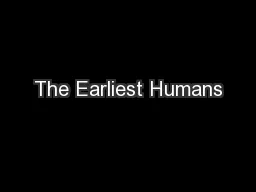

Student Handouts Inc First Theories of Human Evolution Charles Darwin On the Origin of Species 1859 First to link biological diversity to evolution Thomas Huxley Evidence as to Mans Place in Nature ID: 472597
Download Presentation The PPT/PDF document "The Earliest Humans" is the property of its rightful owner. Permission is granted to download and print the materials on this web site for personal, non-commercial use only, and to display it on your personal computer provided you do not modify the materials and that you retain all copyright notices contained in the materials. By downloading content from our website, you accept the terms of this agreement.
Slide1
The Earliest Humans
© Student Handouts, Inc.Slide2
First Theories of Human Evolution
Charles DarwinOn the Origin of Species
(1859)
First to link biological diversity to evolution
Thomas Huxley
Evidence as to Man’s Place in Nature
(1863)
First book to describe human evolution
These scientists wrote about human evolution before human fossil evidence was ever discoveredSlide3
Fossil Evidence for Evolution
PaleontologyStudy of prehistoric life of all forms, typically using fossils
Paleoanthropology
Study of prehistoric human life (and human ancestry), typically using fossils
Mary and Louis Leakey
Lifetimes dedicated to finding fossil evidence of human ancestors in Africa
Olduvai Gorge
“The Cradle of Mankind”
Great Rift Valley in eastern Africa (Tanzania)
Erosion reveals layers of datable artifacts, bones, and fossils going back 2,000,000 yearsSlide4
Hominid Evolution
Hominids = “great apes”Chimpanzees, gorillas, humans, and orangutans
Numerous intermediary fossils have been found
But scientists disagree on which are human ancestors and which are evolutionary dead endsSlide5
Human Evolution
Homo habilis2.4 to 1.4 million years agoFossils found in southern and eastern Africa
Used simple bone and stone tools
Nicknamed “handy man”
Homo erectus
1.8 million years ago to 70,000 years ago
First human ancestor to walk fully upright (bipedal)
Some made complex stone tools
Example – “Peking Man”
Descendants were humans and
neanderthalsSlide6
Neanderthals
Homo sapiens
neanderthalensis
Circa 400,000 to 30,000 years ago
Lived in Europe and Asia
Archaeogenetics
– analysis of ancient and modern DNA
Comparison of human and Neanderthal DNA shows that humans are not descended from Neanderthals
Genes reveal that Neanderthals had red hair and fair skin
Fair skin developed to aid in the absorption of Vitamin D from the sun in areas far north of the equator
Convergent evolution
– different species (such as humans and Neanderthals) developing same characteristic(s)Slide7
Humans – Homo sapiens
“Homo” (Latin) means “man” or “human”
“Sapiens” (Latin) means “wise” or “intelligent”
“Homo sapiens” = “wise man” or “wise human”
Humans and Neanderthals both considered “sapiens”
Anatomically modern humans in Africa by 200,000 years ago
Middle Paleolithic
periodSlide8
Mitochondrial “eve”
Mitochondrial DNADNA that is passed from women
Mitochondrial “Eve”
Lived 60,000 to 250,000 years ago
Most recent common female ancestor of all living humans
Lived in or around modern-day Tanzania in Africa
She was part of a group of early humans
But only her mitochondrial DNA survives todaySlide9
Y-chromosomal “Adam”
Y-chromosomeDNA that is passed from men
Y-chromosomal “Adam”
Circa 60,000 years ago
Most recent common male ancestor of all living humans
Lived in Africa
He lived as part of a group of early humans
But only his Y-chromosome survives todaySlide10
Humans – Homo sapiens
sapiens – “Us”
Fully modern humans (like us) in Africa by around 60,000 years ago
Descendants of Mitochondrial Eve and Y-chromosomal Adam
Culture, language, music, etc.
“Out of Africa” theory
Archaeogenetics
(analysis of ancient and modern DNA) shows that humans began spreading throughout, and out of, Africa beginning around 60,000 years ago
Early human migrations
Humans left southeastern Africa and spread throughout the continent
Humans traveled along the Indian Ocean to reach Australia
By 10,000 years ago, modern human beings had spread all over the globeSlide11
Early Human Migrations: Route of
mDNA
Numbers are thousands of years before the present.
← Africa
↑
North AmericaSlide12
Review Questions
Who were the two people to describe human evolution?
What family of paleontologists dedicated their lives to finding the fossils of human ancestors at Olduvai Gorge in Africa?
What has
archaeogenetics
told us about Neanderthals?
Describe Mitochondrial Eve?
Describe Y-chromosomal Adam?
Describe the “Out of Africa” theory.
What parts of the world were the first to be settled by modern humans? The last?Slide13
Vocabulary for “Human Origins”
Anthropologyarchaeologist
h
ominid
archaeogenetics
Paleontonlogy
prehistoric
migration
m
itochondrial DNA
neanderthal
Homo
sapien
bipedal
Copy each word. Underline or highlight the word and write the definition of the word, along with putting each word into a sentence (using it correctly in the sentence
) 3 marks each